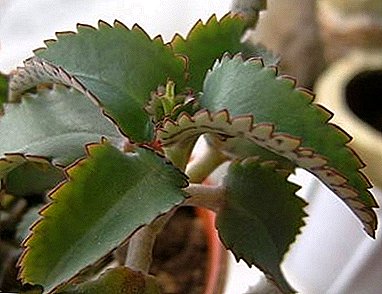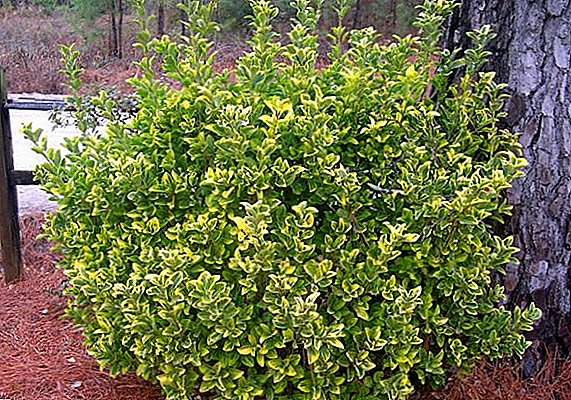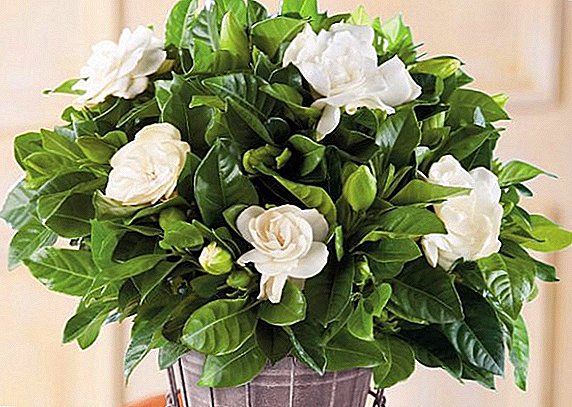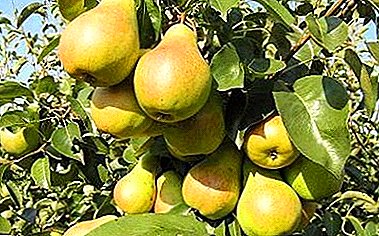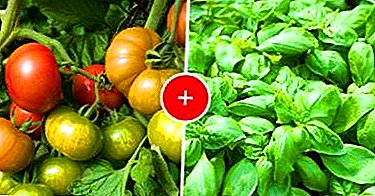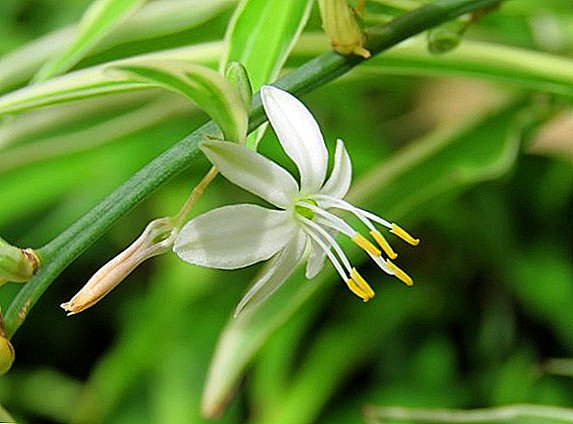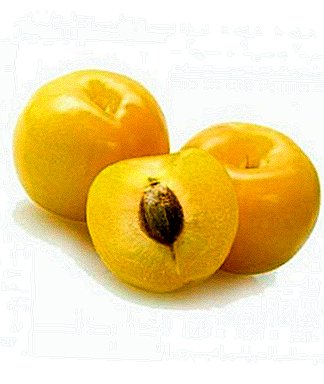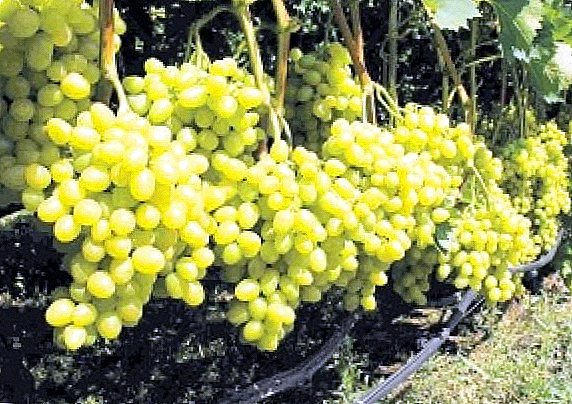
The variety of grapes called "Laura" has long been the favorite of many fans of viticulture.
His extraordinarily beautiful clusters and are asked to be removed from the branches of the bush and immediately tried.
"Laura" is one of the most common varieties of amber grapes, which can most often be found on the markets and summer cottages.
The most experienced gardeners know this variety under another, younger, name - "Flora".
It is about this high-yielding table grape variety and we will tell you below, and let's not forget to share the experience of professionals in the planting and cultivation of vines.
We share the main secrets of the success of the Laura grape variety among gardeners
This variety was produced by the Ukrainian scientists of the Odessa Institute, who managed for this to cross 4 other grape varieties. In particular, at first a variety called “Muscat de Saint-Valle” was pollinated with a mixture of pollen varieties “Muscat of Hamburg” and “Husayne”, after which the result of this crossing was also mixed with “Queen of Tairovskaya” grapes.
Distinctive features of bunches of the most beautiful grapes "Laura"
The Laura grape variety can easily boast very huge clusters, which at the time of removable maturity reach a mass of at least one kilogram. For grapes, these figures are very high, especially when you consider that the mass of individual grapes-champions was about 2.4 kilograms. Accordingly, the average length of a bunch of grapes of this variety is also impressive - it is equal to 40 centimeters.
The shape of the clusters is most often found to be tapered, with a medium dense or friable structure of placing berries on it. It is worth noting that the peculiarities of the formation of the structure of the bunch in the Lora variety are very much dependent on the strength of the growth of the bush and on how well the pollination of the grape inflorescences was conducted.
Grape berries of this grade also correspond to the sizes of clusters. In this way, The average weight of the grapes "Laura" is 8-9 grams. With good care, the berries can even reach a mass of 12 grams. They are characterized by an oval-oblong shape. The length of the berry can be up to 4 centimeters.

The appearance of the berries is very beautiful. Their color is mostly white, with a characteristic light-green tint, which makes the grapes "Laura" amber. Sun exposure may cause sunburn on one side of the berry. The skin of the berry is covered with a thin layer of wax.
Pulp grape varieties "Laura" is characterized by high density and juiciness, the presence of a small number of seeds. The taste of this grape variety is very rich and pleasant, has similarities with the most common Central Asian grape varieties, which is displayed in the muscat flavor.
In general, the sugar content of aromatic substances in the chemical composition of grapes is quite high. Thus, on average, the sugar content in the pulp of the grape berries of this variety is equal to 20% of the content of other chemicals, with the acidity of the fruit at 6-8 g / l. However, the growing conditions of grapes of this variety can greatly affect the quality of fruits, qualitatively reducing their taste.
Using grape varieties "Laura" most often table. It is very suitable for fresh consumption. But for processing it is suitable - amateurs who grow this variety in their backyards often use this variety for winemaking.
Distinctive features of the bush and yield of grapes "Laura"
The grape bush "Laura" usually grows very heavily. On one bush may be about 40-50 eyes. During the period of fruiting the bush enters very quickly after planting or vaccination - for 2-3 years. The shoots of grapes are very well developed, most of which (about 60-80%) are suitable for fruiting.
On one shoot, 0.9-1.3 grape clusters are formed in average, which provides very high yield of this variety.
Clusters form on shoots with angular eyes. The flowers of grapes have only female function, therefore, to obtain the harvest they must be pollinated with the help of pollen from other grape varieties.
It is worth paying attention to some peculiarities of fruiting and the ripening time of grape bunches of the variety “Laura”. In general, a large number of clusters can form on a large bush. However, with an increase in their number, their total weight decreases. So, with maximum values of 40-45 clusters, their weight can be 2-3 times lower than the average value, and be only half a kilogram.

Thus, despite the fact that usually This grape ripens very early, approximately after 110-120 days of the vegetative period, with a large number of grapes and the term of their ripening is delayed. Thus, with the indicated harvest volumes, the removable ripeness of the grapes begins only at the end of the grapes, together with medium and late-mature varieties. Also, the consequences of such a rich formation of bunches can be that the following year a bush can throw off absolutely the entire ovary.
Also, often even on very large bushes, only 15–18 grapes can be tied. In this case, their maturity comes a month earlier than usual - in August. Such clusters will necessarily be very large, which, in principle, can partially compensate for a small amount of the crop. However, such an underload may cause the bush to re-enter the growing season before the end of autumn.
This is strictly not allowed. Therefore, the characteristics of the formation of yields of this variety should be monitored very carefully and try to maintain the most optimal variant of the load of the grape bush - about 23-27 grapes. At the same time, it is very important that about 30% of single, non-fruiting shoots are present on the bush.
The main advantages of the grape variety "Laura"
Despite the large size of the grapes, the berries of this class are very well suited for transportation and relatively long shelf life. In addition, the berries ripen very quickly and have a great taste.
Also, in many sources, the Laura grape variety is characterized as complex-resistant. This refers primarily to the high resistance of the grapes in front of the gray rot and the fact that the berries are able to tolerate high humidity without cracking well. There is a high resistance to fungal diseases, which are most often found on vines.
In addition, the bush of this variety perfectly tolerates even very low temperatures: it is almost not affected when lowering the thermometer to the mark of -21-23ºС, although protective measures are still worth taking.
A positive quality of the grapes "Laura" is the fact that the clusters are very well attached to the shoots of the bush. Thus, even with abundant harvests and after the onset of removable ripeness of grapes, it does not crumble.

Disadvantages of grapes "Laura": is it worth paying attention to them?
Although there are few drawbacks in this variety, they should not be overlooked, since they can be overcome with the strength of each. So, very often it happens that the taste of grapes is reduced, the berries become less sweet than usual. The reason for this may be a strong-growing grape bush (and especially a strong and large stock, to which the cutting of the Lora variety has been grafted), a cold and rainy summer.
Therefore, you should constantly monitor the number of clusters formation and reduce them to the average accepted number. The big drawback of the berries is that they can often be affected by the mildew. Also, due to the high content of sugars in its composition, it is practically impossible to imagine a bunch of "Laura" without wasps.
What you need to know in order to properly plant grapes "Laura"
In order for the grapes to grow very good and perfectly fruited, it is necessary to take into account many nuances. In particular:
- The soil for planting grapes "Laura" can be any, except clay and with a high salt content. It is not recommended to plant grapes where ground water is very close to the surface of the ground.
- For planting this grape variety is better to choose a place that is well lit by the sun and not blown by drafts.
- Lushe only grapes grow and bear fruit in the southern regions. In Central and more Northern it is best to plant it near the wall or fences, so that as much sunlight as possible falls on the grapes.
When and how best to plant a grape bush?
The best time for planting grapes in the South is the period from October to March. In colder regions, plant grape seedlings or plant cuttings best in the spring. It is very important that during planting the temperature of the air is not less than + 15ºС, and the temperature of the soil is about + 10ºС.
Planting of grapes is carried out either with the help of saplings, or by grafting cuttings on an old stock. Despite the fact that planting by seedlings is considered to be more simple and efficient, thanks to the graft, you can get the first yields much faster. This is explained by the fact that when grafting a cutting onto an adult stock with an already developed root system, it is able to receive much more nutrients and develop more quickly.
Planting grapes "Laura" sapling - the main instructions
For planting grapes using seedlings it is very important to prepare a hole in advance. Its depth should be twice the size of the roots of the seedling, so that even fertilizer can be poured at its bottom. It is simply impossible to fill in fertilizers in this way, it is better to mix it with the upper fertile soil layer dug out from the same pit.

The distance between seedlings should be not less than 1-1.5 meters. From the support or the wall you need to retreat by 40 centimeters. If the seedling is planted freely, then the distance between the bushes and rows of bushes must be at least 1.5 meters.
A grape sapling is planted on top of a hill filled with fertilizers, after two or three weeks. It is very important that the grafting site of the seedling remains above the soil for 10 centimeters. It is necessary to fill the sapling slowly and gradually, carefully filling the pit with soil mixed with mineral fertilizers.
After the pit falls asleep, it is very important to consolidate the soil and to build a solid support near the pit (for the grapes are a shrub that cannot grow on its own, and without support it will travel along the ground). After watering, the grapes must be watered, and the soil around the seedling is mulched.
Planting Laura grape bush by grafting
If on your site there is already an old bush of grapes that you are already fed up with, you can graft a “Laura” variety on its stem. For this it is very important:
- Prepare and parffle the cutting in advance so that it is more stable. Also, in order to better stimulate rooting before grafting, it is important to hold it in water and dip it for a few seconds in the “Humate” solution.
- The stalk needs to be cut with a wedge so that it leans against the trunk split better.
- Accordingly, the shtamb of the old bush must be carefully split, so that only the cutting can fit into it (several cuttings can be grafted onto one).
- Having placed the stem in the split of the stem, it must be clamped very well in order for the stem to take root faster and better. For this, it is tightened with a durable cotton fabric. If a
- the inoculation is carried out for the winter, then the seedling should be smeared with clay and okulirovat using soil.
It is also interesting to read about the treatment and prevention of diseases of the vine.
Learn the basic rules for the care of grapes "Laura"
- Watering the vine requires constant and regular. Particularly demanding to watering those bushes that were planted near the wall. To carry out watering is in a special drainage grooves dug along the diameter of the root system of the bush. Watering under the shtamb is especially dangerous, since the roots near the trunk are not able to absorb water. The amount of water needed by a grape bush at a young age is 30 liters, in a more adult and when fruiting - about 60 liters.
- To keep the moisture in the soil longer and really nourish the roots of the vine, it is very important to mulch it. To do this, use organic fertilizers, which will also fertilize the soil. Layer compressed compost need to lay out at least 3 centimeters. Mulching is best done only in the fall and only in the spring. In the summer, mulching can steam the soil and grape roots.
- Correct harboring a grape bush will help protect it from the effects of adverse weather conditions. A young, only planted shrub can be completely covered with soil, thus saving it both from frost and rodents. Older bushes are sheltered by mulching and hay use.
- In the first years after landing pruning grape bush "Laura" not carried out. But, together with its entry into the fruiting period, it is important to carry out this process regularly every autumn. It is necessary to develop to give three or four main stems, which will eventually gain in thickness. Every autumn it is very important to prune all young shoots so that they do not freeze in winter. Also, it is necessary to completely remove those shoots of the grape bush, which dried out and do not fully bear fruit. Very strongly cut the grapes "Laura" can not, because you can absolutely stop their growth. Leaving a lot of shoots is also not worth it, do not happen that with the excessive formation of clusters, the quality of the grapes will decrease and may even disappear for one year.
- Feed the grapes "Laura" should be regularlybut not plentiful. It responds very well to fertilizer. It is better to use universal mineral fertilizers, which can comprehensively affect the growth of the bush and grapes. To compensate for the lack of magnesium, it is necessary to spray the bush with magnesium sulfate in the amount of 250 grams of the substance per 10 liters of water.
- Since most often Laura grapes suffer from mildews, when signs of a grapevine defeat appear, this pest is worth it. process with bordeaux fluid. Also, grape bushes, especially in older age, may be affected by the autumn growth. In this case, leave the bush is not worth it. It is recommended to dig and burn. The soil must also be sterilized, otherwise the defeat will necessarily recur.




